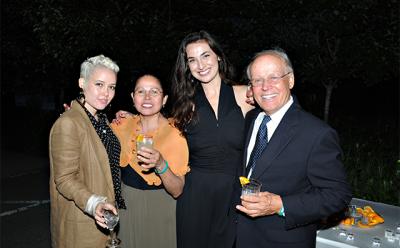Move Aside, Tequila, Here Comes Mezcal

The buzzwords surrounding mezcal these days emit a certain energy. Vogue says the spirit has a “romantic appeal,” Los Angeles magazine says drinking mezcal is an “academic experience.” Others have called it “trendsetting,” “artisanal,” and “the best-kept secret of Mexico.”
Lisa Schock, who runs the tasting bar at Park Place Wines and Liquors in East Hampton, uses the word “complex” when it comes to Dona Sarita Mezcal Blanco, a label launched in the U.S. in 2012 by East Hampton Importers.
“I’d say in the last five to seven years, every year mezcal has gotten more and more popular,” Ms. Schock said. “The Dona Sarita is kind of unusual. It always gets a positive response, and we sell quite a lot of it.”
The people behind East Hampton Importers are none other than the Kiembocks, who have lived here for about 40 years and own the Village Hardware store on Newtown Lane in East Hampton. Bernhard Kiembock said they first discovered the joys of mezcal about 22 years ago, during family trips to Zihuatenejo and Ixtapa in Mexico. While the gringos were ordering margaritas, the natives were calling for mezcal shots. Naturally, the Kiembocks tried mezcal for themselves, and were immediately enchanted by its flavors. On more recent trips, they decided to import mezcal to Long Island.
“Before this, I used to drink tequila,” Mr. Kiembock said. “Once we discovered the mezcal, we found that it was far superior.”
Tequila is well known in this country, but it probably won’t be long before mezcal, which is a kind of rustic cousin, has the same name recognition. The Dallas Morning News reported in December that the spirit is surging in popularity, with its American market having grown to $126 million from $10 million about a decade ago.
Both tequila and mezcal are made from the agave plant, though tequila comes from a specific type, the blue agave. Dona Sarita is made from the hearts of the espadin agave, roasted for several days in pit ovens over hot rocks, then crushed. The juices are extracted and distilled, producing the spirit.
Most mezcals have a smoky finish, and the Kiembocks’ Dona Sarita organic mezcal is no different, but what sets it apart is a peppery mouthfeel before the smoke sets in. It’s a sipping drink, rather than a shooting drink. It pairs well with citrus and light hors d’oeuvres. In particular, taking a bite from an orange before sipping this mezcal will bring out all the nuances the spirit has to offer.
Dona Sarita has received an 85-point rating from Wine Spectator magazine. It won a gold medal and best-of-show award at the 2014 Los Angeles International Spirits Competition, and in 2012 won two gold medals at the World Wine and Spirits Competition in New York City.
Mr. Kiembock said many Manhattan restaurants and bars are now serving the Dona Sarita brand, and he hopes more on Long Island and in Connecticut will follow. “They have found that our mezcal is wonderful for mixing drinks, because it is very smooth, so it’s getting more and more of an acceptance,” he said.
His wife, Sara Kiembock, created the “Dona Sarita cocktail” herself by experimenting with different concoctions of complementary ingredients. She finally arrived at a particularly powerful combination using Triple Sec or Cointreau, lime juice, orange juice, and red chile salt (see accompanying recipe for details).
“This one stood out more so than the other ones she tried,” Mr. Kiembock said. “She is a very good mixologist.” His wife, he added, smiling, “is the one that said, ‘Margarita, move aside. Here comes Sarita.’ ”
His daughter, Rebecca, is working to build up the brand in New York City, and the family is also working with a West Coast company for distribution in five more states. There are plans to release additional varieties, too, including a “Reposado” label for a one-year-old mezcal, a “Reserva” label for a five-year-aged spirit, and a “Free Range” label made from wild agave that grows at an altitude of 5,000 feet.
“I think it’s more of a recreational drink,” Mr. Kiembock said. “It’s so unique and so different that we felt there was an opportunity for us to do something with it.”
Click for recipe
